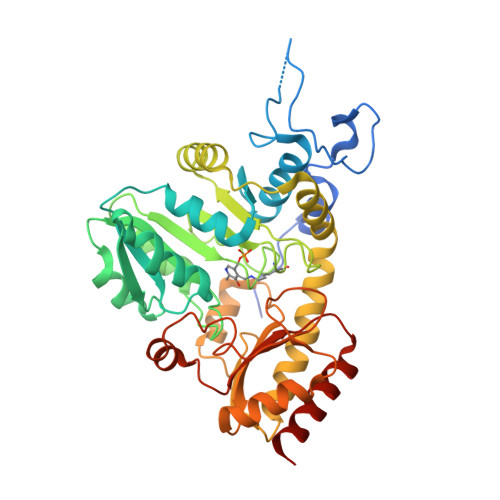Enzyme-mediated depletion of serum l-Met abrogates prostate cancer growth via multiple mechanisms without evidence of systemic toxicity.
Lu, W.C., Saha, A., Yan, W., Garrison, K., Lamb, C., Pandey, R., Irani, S., Lodi, A., Lu, X., Tiziani, S., Zhang, Y.J., Georgiou, G., DiGiovanni, J., Stone, E.(2020) Proc Natl Acad Sci U S A 117: 13000-13011
- PubMed: 32434918
- DOI: https://doi.org/10.1073/pnas.1917362117
- Primary Citation of Related Structures:
6OVG - PubMed Abstract:
Extensive studies in prostate cancer and other malignancies have revealed that l-methionine (l-Met) and its metabolites play a critical role in tumorigenesis. Preclinical and clinical studies have demonstrated that systemic restriction of serum l-Met, either via partial dietary restriction or with bacterial l-Met-degrading enzymes exerts potent antitumor effects. However, administration of bacterial l-Met-degrading enzymes has not proven practical for human therapy because of problems with immunogenicity. As the human genome does not encode l-Met-degrading enzymes, we engineered the human cystathionine-γ-lyase (hMGL-4.0) to catalyze the selective degradation of l-Met. At therapeutically relevant dosing, hMGL-4.0 reduces serum l-Met levels to >75% for >72 h and significantly inhibits the growth of multiple prostate cancer allografts/xenografts without weight loss or toxicity. We demonstrate that in vitro, hMGL-4.0 causes tumor cell death, associated with increased reactive oxygen species, S-adenosyl-methionine depletion, global hypomethylation, induction of autophagy, and robust poly(ADP-ribose) polymerase (PARP) cleavage indicative of DNA damage and apoptosis.
- Department of Chemical Engineering, The University of Texas at Austin, Austin, TX 78712.
Organizational Affiliation:


















